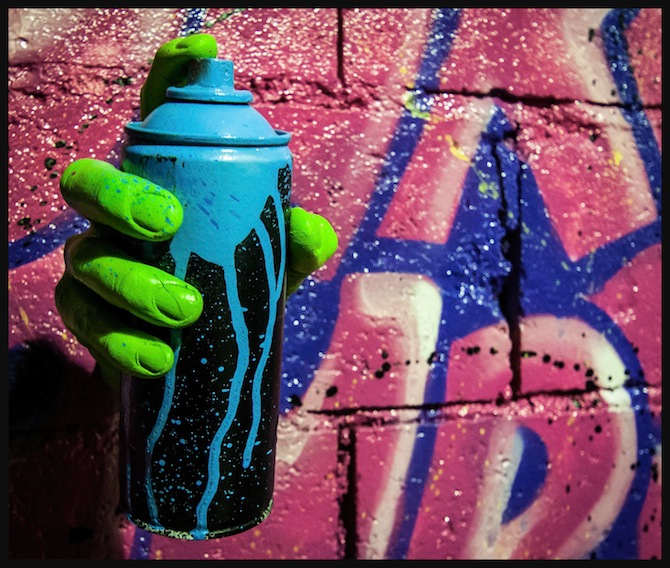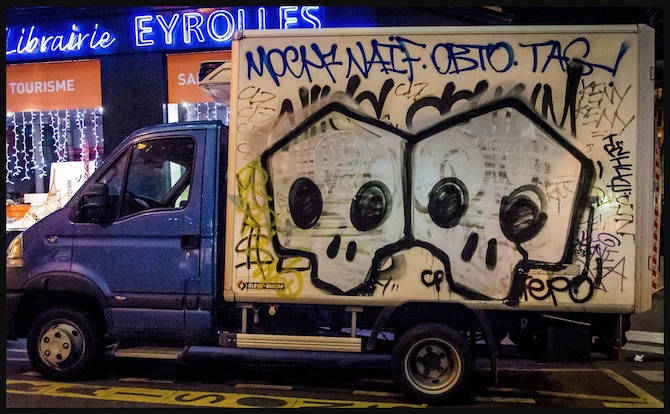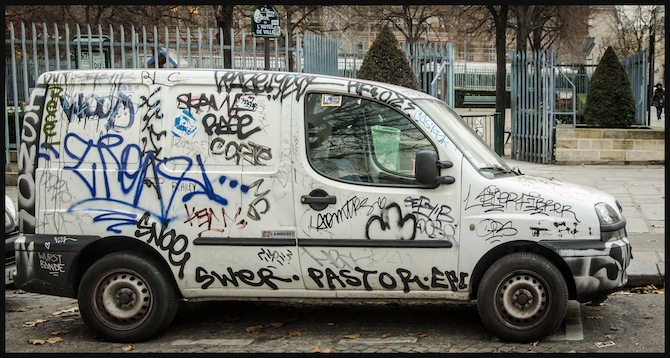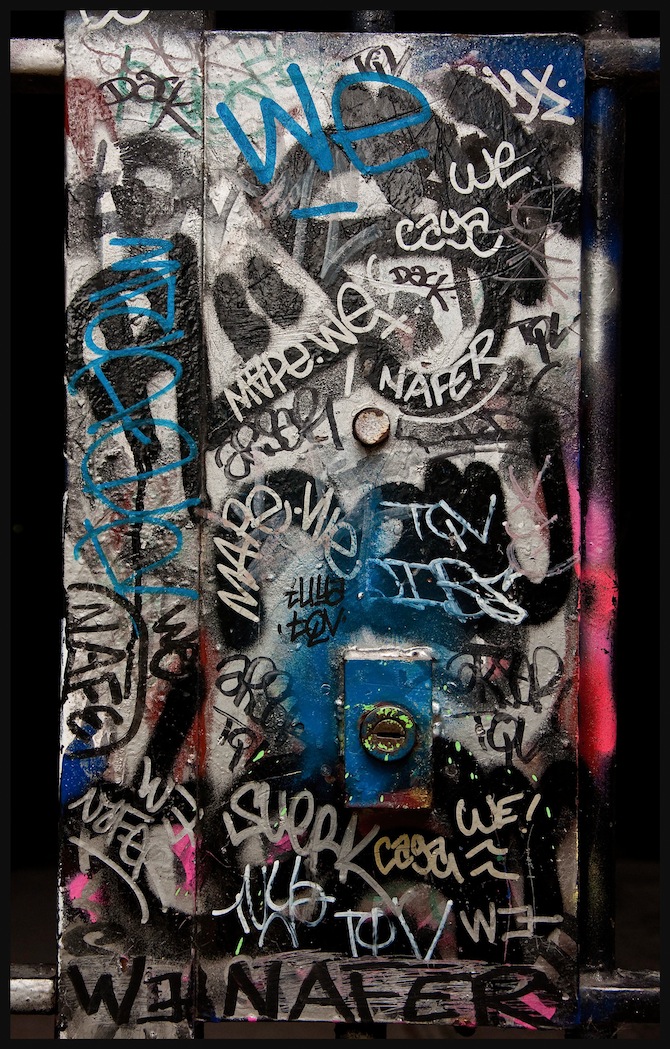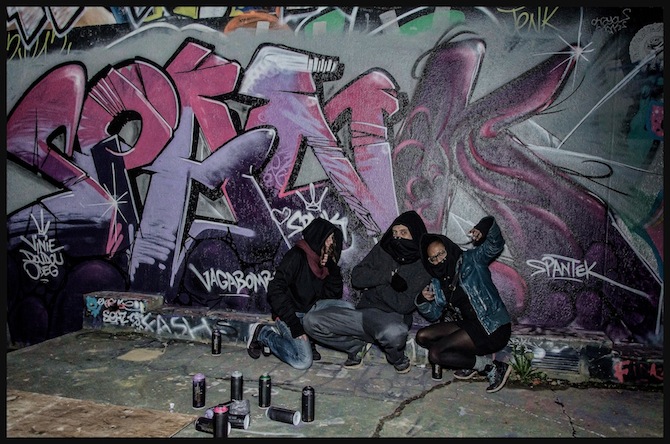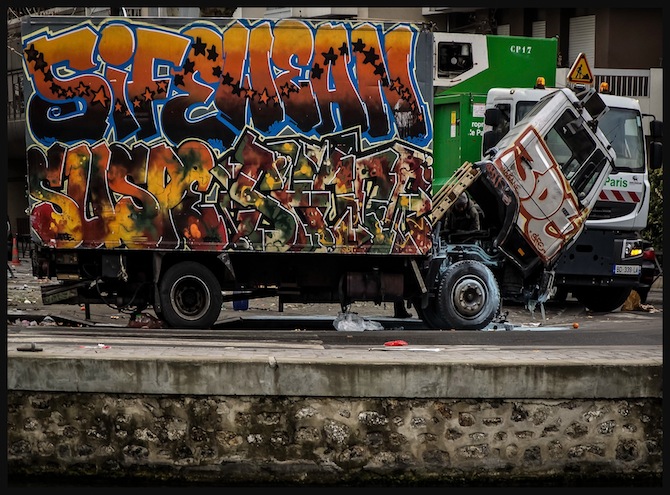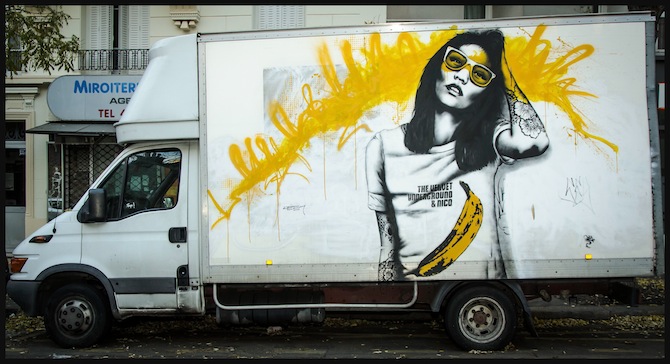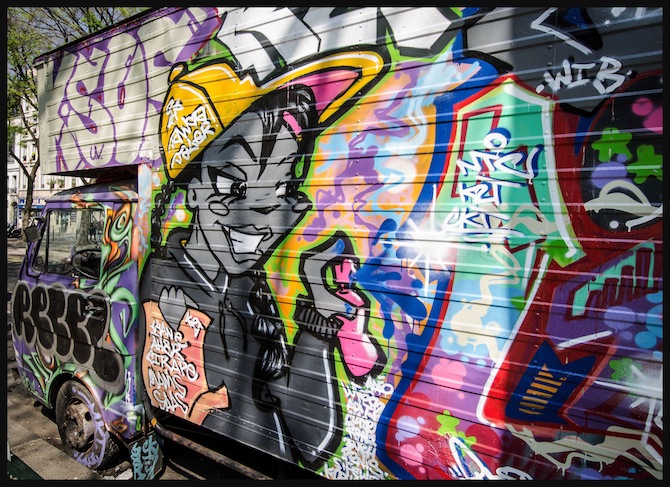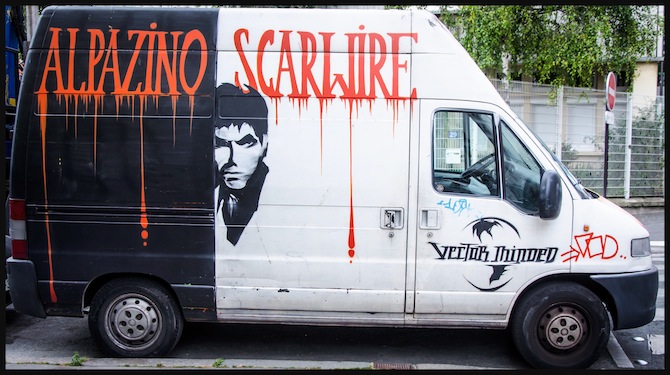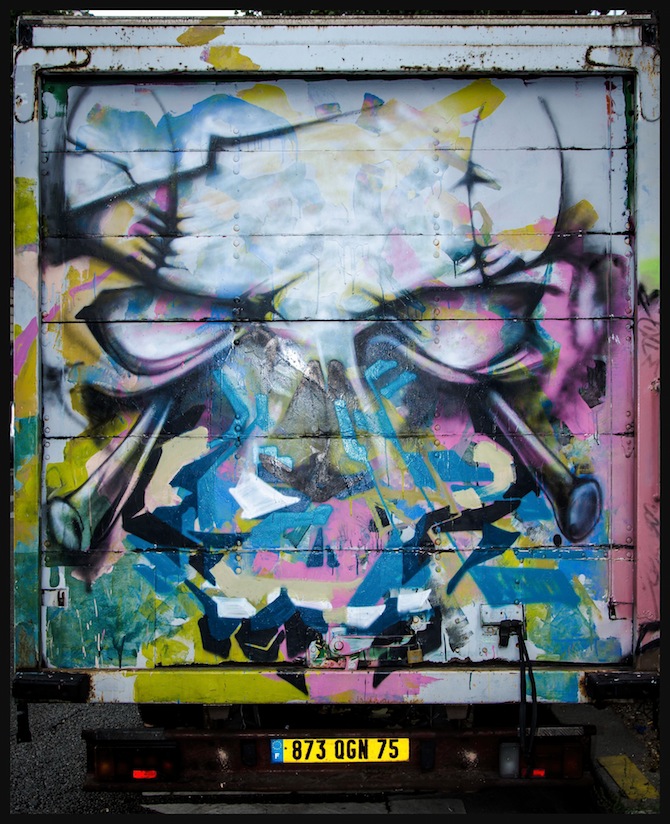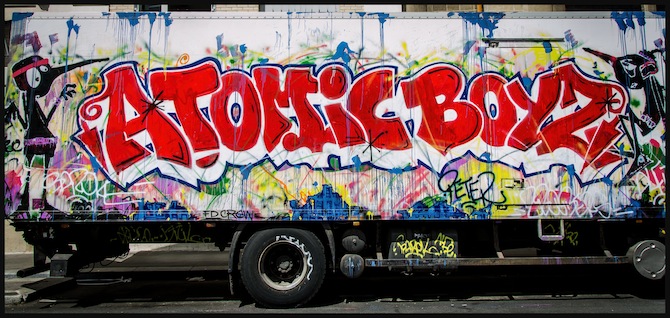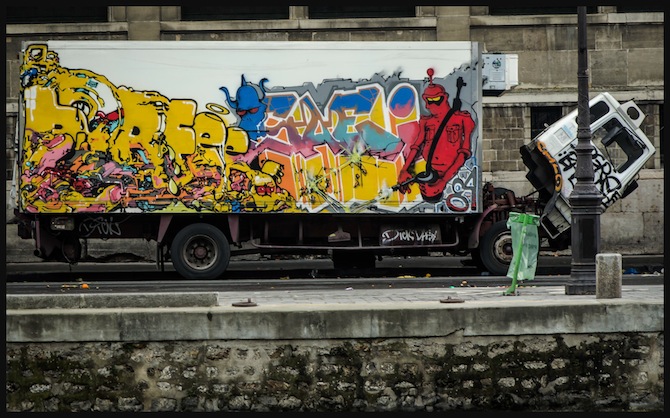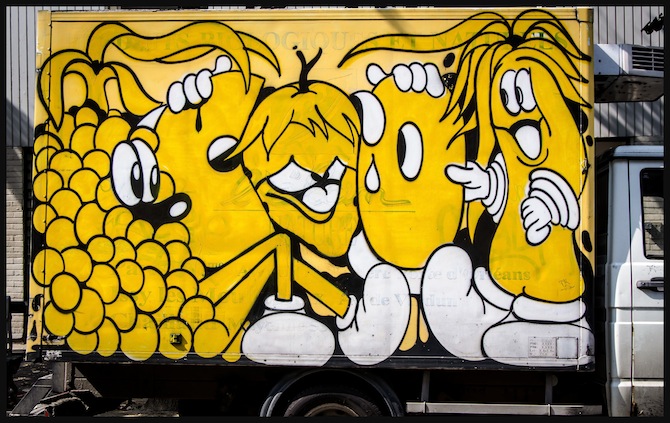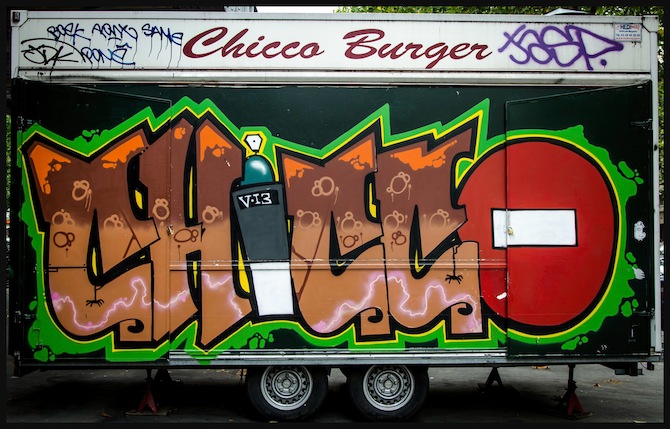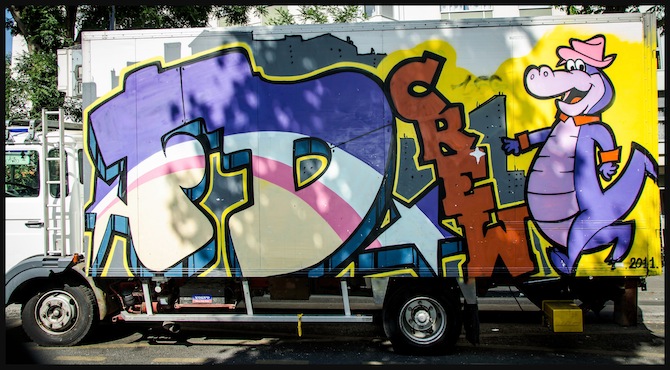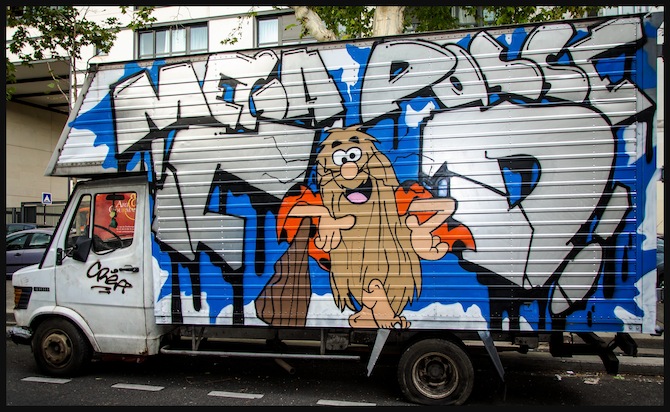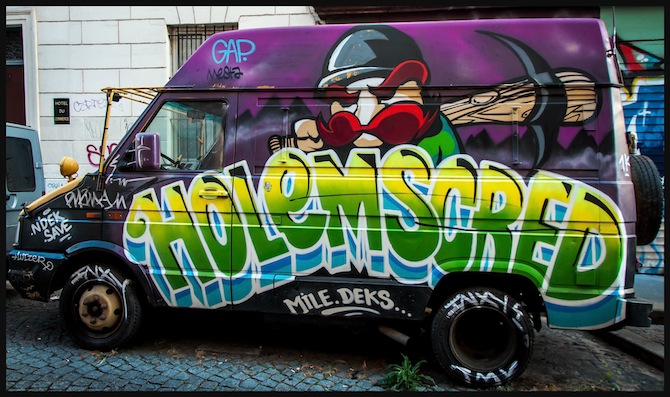"I Love You Touch My Pieces" (Surrealist Translation)
 06.13.2014
06.13.2014  Artwork © 2014 Madame Moustache. Additional art © 2014 Pole Ka.
Artwork © 2014 Madame Moustache. Additional art © 2014 Pole Ka.
After a three-month break for other writing projects, we're back. Here is an interview in French, by writer Sophie Pujas, of the collagist street artist, Madame Moustache. (Thanks, Veronique Mesnager, for the link).
Although we understand the French, I wanted to translate it (quickly) for those Paris Play readers interested in wonderful street art, especially collage. So I ran the article through Google Translate. There is something surreal and delightful to us in this fractured translation.
Richard's photographs were taken on a recent morning outing with Madame and her paste-up buddy, Fred le Chevalier, that began with a civilized morning espresso in an 11th arrondissement café. Madame requested that we not show her face.
Here you go:


* * *
Madame Moustache: "I do not pretend to be outlawed"
Art - Street Art
Madame Moustache, currently exposed to Sète in the K-Live festival, poetizes streets surrealist collages perfume and retro. Meeting.
Where are you from?
I come from a family of artists. My grandfather and my father were painters ... I have always refused to do. Although I've always drawn, I did not feel my shoulders to carry the family tradition ... I was an actress before becoming a designer. I made small drawings, collages, travel diaries when I was traveling, where again I stuck stuff ... I started to collage, because technically, with drawing, I could not express what I wanted. At the same time, I was hanging out in Paris with lots of graffiti. I made my first collage to the Canal Saint-Martin there is a little more than three years. It was a big monkey with an elephant's trunk. It is so fine that it has done me good, I found it easy. It was not crooked, I asked where I wanted ... I started small, and bigger and bigger.
 Artwork © 2014 Madame Moustache
Artwork © 2014 Madame Moustache
 Artwork © 2014 Madame Moustache. Additional art © 2014 Pole Ka.
Artwork © 2014 Madame Moustache. Additional art © 2014 Pole Ka.
 Artwork © 2014 Madame Moustache
Artwork © 2014 Madame Moustache
Designer, was already an appropriation of space. He left something in your street work?
I realize that yes. Especially since recently, I rotated on many objects - things that I can touch to act on it, slightly changing the meaning. In the same way that I am influenced by the images of Epinal. I always like this is a bit hidden, what does not discover at first glance. Hence the fact of choosing objects can I divert, lit and extinguished lamps, build boxes ... I love being surprised. When I like an artist, I like to be surprised that he changed support, colors ... I hate boredom, and I hate that I think of Lady ... So I try to diversify although I think I'll stick still in the street - I love it too.

Why this retro universe?
I grew up in the workshop of my grandfather, full of old things, and I had the chance to let me touch it. Brushes, palettes, I tripatouillais ... There was a large buffet in his studio, under a large canopy, and I see myself with a book of gold leaf in hand, I had dug there, and he let me browse the sun ... I've always been in the permissive handling is also why I love you touch my pieces! I've kept this messy side - there is always something behind ... I'm very attached to the nostalgia, the taste of childhood ...
But it is a nostalgia plays with irony, offset ...
Always. I do not like people who take themselves seriously. I can not imagine work without me laugh. So I feel that people are laughing looking at my items. Since I put on the street, I need to create something. I did not want to stick something and people do not understand. Even if there is a double or triple meaning in one of my collages, I feel that the first reaction of passers-by or smile. They feel that there is something funny. I stick express day to see the reactions. I just stuck the night, at first, and it did not fit me at all. I am not a vandal, I do not claim to be outlawed. I claim nothing, if not tolerance or questions. I like to discuss, even with some who do not. I understand - I needed something sticky on the street!
 Artwork © 2014 Madame Moustache
Artwork © 2014 Madame Moustache
Why the question of identity, such as you take to heart?
Since forever, I asked a lot of questions about it. I think it goes back to a childhood trauma. I had very long hair and one of my friends asked me to play at the hairdresser. I thought she would pretend, and she cut my hair flush ... For several months I was treated boy! I hang with a lot of guys, I do not let me piss ... My work is also related to the fact that today I do not understand how anyone can still judge people on their identity or sexual preferences . By what right? I think we're both in us, a little masculine, a little feminine. It is not necessarily predestined to love someone of the opposite sex, we have the right to try both, to test ... You brought me in tolerance.
Mustache with which you sign, it is the emblem of this claim?
Of course! I love bias borders. I like from saying stuff man, or vice versa this very girly picture: a very big makeup guy who rips the heart by saying ultra sensitive stuff you. I really like to mix the two, while trying not tired, not systematic or become redundant. In my cultural journey, I was also influenced by the punk that my brother loved or images transgender 80s.
Where are the images that you use for collages?
Magazines of the early twentieth century until the 70 maximum. After, colors and materials change. I like to keep some obsolete thing. I like the idea of craftsmanship, this is a little damaged, we do not know quite where the image has been edited or not. This is still a story of transgression: transgression of the time, the style ...
 Artwork © 2014 Madame Moustache. Additional art © 2014 Fred le Chevalier.
Artwork © 2014 Madame Moustache. Additional art © 2014 Fred le Chevalier.
 Artwork © 2014 Madame Moustache. Additional art © 2014 Fred le Chevalier.
Artwork © 2014 Madame Moustache. Additional art © 2014 Fred le Chevalier.
You feel close to a certain tradition of collage - surreal or Dada, for example?
Not at all. Of course, I was in the museum when I was little, and surely I have certain things. But I purposely avoided looking at, I do not want to be influenced. I do not want to dada! When I look at the pastels I did at one time, I think it looks the Chaissac. I did not do it consciously, but I had seen too kid because my parents loved ... And I do not want to spit out something that I was taught there a thousand years! I am afraid of being influenced, but also to compare me. I like to go see something else feed me art that does not look at all like what I do. I love art brut, for example, or photo.
Why decline on objects?
If it runs, is that it touches. I sell very expensive products, not as bags or serigraphs, so that it circulates. I do not pretend to live ...
 Artwork © 2014 Fred le Chevalier
Artwork © 2014 Fred le Chevalier
You feel in dialogue with other street artists?
Especially with Fred Knight [Fred Le Chevalier]. It much glue to one side of the other. Suddenly our dialogue works, and we're both big on words. He and I, we are very tortured, and is found on many points, such as the genre. But I do not necessarily seek this kind of dialogue. At the moment I tend to go to places where there is nothing. I'm a bit tired of places where garbage, when you arrive, there is already stuff loosely bonded, and finally where you can not see anything, there are more surprise. At first I tried a bit of dialogue with what was there, now it interests me less. And then I make bigger and bigger, so I need walls where there is nothing!
 Artwork © 2014 Madame Moustache
Artwork © 2014 Madame Moustache



